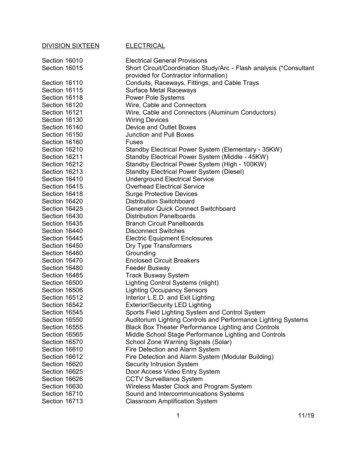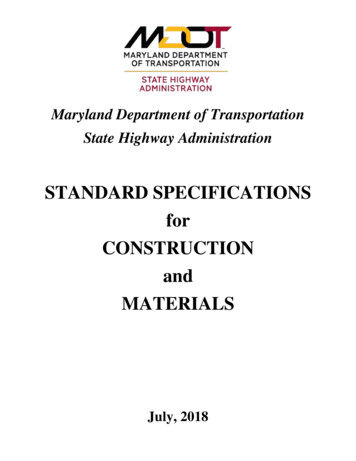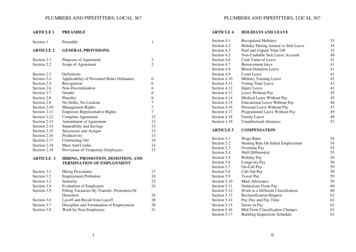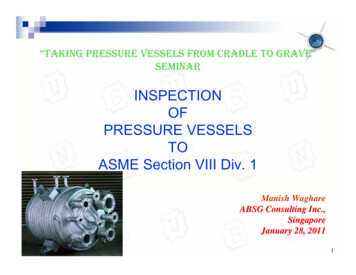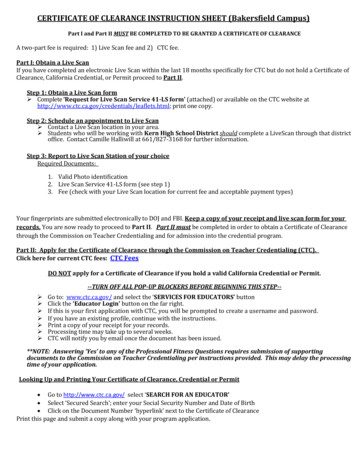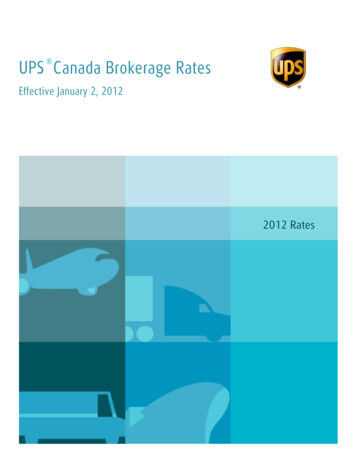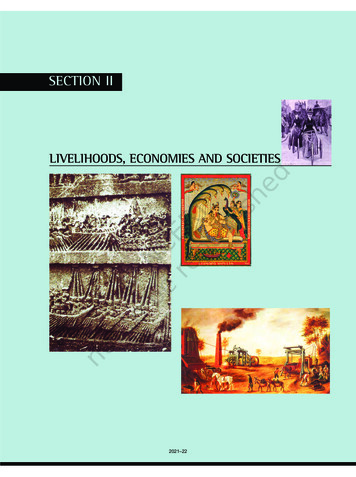
Transcription
SECTION IILIVELIHOODS, ECONOMIES AND SOCIETIES2021–22
2021–22
Chapter IIIThe Making of a Global World1 The Pre-modern WorldWhen we talk of ‘globalisation’ we often refer to an economicsystem that has emerged since the last 50 years or so. But as you willsee in this chapter, the making of the global world has a longhistory – of trade, of migration, of people in search of work, themovement of capital, and much else. As we think about the dramaticand visible signs of global interconnectedness in our lives today,we need to understand the phases through which this world inwhich we live has emerged.MakingofThe Making of a Global WorldaGlobalWorldAll through history, human societies have become steadily moreinterlinked. From ancient times, travellers, traders, priests andpilgrims travelled vast distances for knowledge, opportunity andspiritual fulfilment, or to escape persecution. They carried goods,money, values, skills, ideas, inventions, and even germs and diseases.As early as 3000 BCE an active coastal trade linked the Indus valleycivilisations with present-day West Asia. For more than a millennia,cowries (the Hindi cowdi or seashells, used as a form of currency)from the Maldives found their way to China and East Africa. Thelong-distance spread of disease-carrying germs may be traced asfar back as the seventh century. By the thirteenth century it hadbecome an unmistakable link.2021–22TheFig. 1 – Image of a ship on a memorial stone,Goa Museum, tenth century CE.From the ninth century, images of shipsappear regularly in memorial stones found inthe western coast, indicating the significanceof oceanic trade.53
1.1 Silk Routes Link the WorldThe silk routes are a good example of vibrant pre-modern tradeand cultural links between distant parts of the world. The name ‘silkroutes’ points to the importance of West-bound Chinese silk cargoesalong this route. Historians have identified several silk routes, overland and by sea, knitting together vast regions of Asia, and linkingAsia with Europe and northern Africa. They are known to haveexisted since before the Christian Era and thrived almost till thefifteenth century. But Chinese pottery also travelled the same route,as did textiles and spices from India and Southeast Asia. In return,precious metals – gold and silver – flowed from Europe to Asia.Trade and cultural exchange always went hand in hand. EarlyChristian missionaries almost certainly travelled this route to Asia, asdid early Muslim preachers a few centuries later. Much before allthis, Buddhism emerged from eastern India and spread in severaldirections through intersecting points on the silk routes.Fig. 2 – Silk route trade as depicted in aChinese cave painting, eighth century, Cave217, Mogao Grottoes, Gansu, China.India and the Contemporary World1.2 Food Travels: Spaghetti and PotatoFood offers many examples of long-distance cultural exchange.Traders and travellers introduced new crops to the lands theytravelled. Even ‘ready’ foodstuff in distant parts of the world mightshare common origins. Take spaghetti and noodles. It is believedthat noodles travelled west from China tobecome spaghetti. Or, perhaps Arab traderstook pasta to fifth-century Sicily, an island nowin Italy. Similar foods were also known in Indiaand Japan, so the truth about their origins maynever be known. Yet such guesswork suggeststhe possibilities of long-distance cultural contacteven in the pre-modern world.Many of our common foods such as potatoes,soya, groundnuts, maize, tomatoes, chillies,sweet potatoes, and so on were not known toour ancestors until about five centuries ago.These foods were only introduced in Europeand Asia after Christopher Columbusaccidentally discovered the vast continent thatwould later become known as the Americas.54Fig. 3 – Merchants from Venice and the Orient exchanging goods,from Marco Polo, Book of Marvels, fifteenth century.2021–22
(Here we will use ‘America’ to describe North America, SouthAmerica and the Caribbean.) In fact, many of our common foodscame from America’s original inhabitants – the American Indians.Sometimes the new crops could make the difference between lifeand death. Europe’s poor began to eat better and live longer withthe introduction of the humble potato. Ireland’s poorest peasantsbecame so dependent on potatoes that when disease destroyed thepotato crop in the mid-1840s, hundreds of thousands diedof starvation.1.3 Conquest, Disease and TradeThe pre-modern world shrank greatly in the sixteenth century afterEuropean sailors found a sea route to Asia and also successfullycrossed the western ocean to America. For centuries before, theIndian Ocean had known a bustling trade, with goods, people,knowledge, customs, etc. criss-crossing its waters. The Indiansubcontinent was central to these flows and a crucial point in theirnetworks. The entry of the Europeans helped expand or redirectsome of these flows towards Europe.Precious metals, particularly silver, from mines located in presentday Peru and Mexico also enhanced Europe’s wealth and financedits trade with Asia. Legends spread in seventeenth-century Europeabout South America’s fabled wealth. Many expeditions set off insearch of El Dorado, the fabled city of gold.The Portuguese and Spanish conquest and colonisation of Americawas decisively under way by the mid-sixteenth century. Europeanconquest was not just a result of superior firepower. In fact, themost powerful weapon of the Spanish conquerors was not aconventional military weapon at all. It was the germs such as thoseof smallpox that they carried on their person. Because of their longisolation, America’s original inhabitants had no immunity againstthese diseases that came from Europe. Smallpox in particular proveda deadly killer. Once introduced, it spread deep into the continent,ahead even of any Europeans reaching there. It killed and decimatedwhole communities, paving the way for conquest.2021–22Fig. 4 – The Irish Potato Famine, IllustratedLondon News, 1849.Hungry children digging for potatoes in a field thathas already been harvested, hoping to discoversome leftovers. During the Great Irish PotatoFamine (1845 to 1849), around 1,000,000people died of starvation in Ireland, and double thenumber emigrated in search of work.Box 1‘Biological’ warfare?John Winthorp, the first governor of theMassachusetts Bay colony in New England,wrote in May 1634 that smallpox signalled God’sblessing for the colonists: ‘ the natives wereneere (near) all dead of small Poxe (pox), so asthe Lord hathe (had) cleared our title to whatwe possess’.Alfred Crosby, Ecological Imperialism.55The Making of a Global WorldBefore its ‘discovery’, America had been cut off from regular contactwith the rest of the world for millions of years. But from the sixteenthcentury, its vast lands and abundant crops and minerals began totransform trade and lives everywhere.
Guns could be bought or captured and turned against the invaders.But not diseases such as smallpox to which the conquerors weremostly immune.New wordsDissenter – One who refuses to acceptestablished beliefs and practicesUntil the nineteenth century, poverty and hunger were common inEurope. Cities were crowded and deadly diseases were widespread.Religious conflicts were common, and religious dissenters werepersecuted. Thousands therefore fled Europe for America. Here,by the eighteenth century, plantations worked by slaves capturedin Africa were growing cotton and sugar for European markets.India and the Contemporary WorldUntil well into the eighteenth century, China and India were amongthe world’s richest countries. They were also pre-eminent in Asiantrade. However, from the fifteenth century, China is said to haverestricted overseas contacts and retreated into isolation. China’sreduced role and the rising importance of the Americas graduallymoved the centre of world trade westwards. Europe now emergedas the centre of world trade.DiscussExplain what we mean when we say that theworld ‘shrank’ in the 1500s.Fig. 5 – Slaves for sale, New Orleans, Illustrated London News, 1851.A prospective buyer carefully inspecting slaves lined up before the auction. You can see twochildren along with four women and seven men in top hats and suit waiting to be sold. To attractbuyers, slaves were often dressed in their best clothes.562021–22
2 The Nineteenth Century (1815-1914)The world changed profoundly in the nineteenth century. Economic,political, social, cultural and technological factors interacted incomplex ways to transform societies and reshape external relations.Economists identify three types of movement or ‘flows’ withininternational economic exchanges. The first is the flow of trade whichin the nineteenth century referred largely to trade in goods (e.g.,cloth or wheat). The second is the flow of labour – the migrationof people in search of employment. The third is the movement ofcapital for short-term or long-term investments over long distances.All three flows were closely interwoven and affected peoples’ livesmore deeply now than ever before. The interconnections couldsometimes be broken – for example, labour migration was oftenmore restricted than goods or capital flows. Yet it helps us understandthe nineteenth-century world economy better if we look at thethree flows together.2.1 A World Economy Takes ShapeA good place to start is the changing pattern of food productionand consumption in industrial Europe. Traditionally, countries likedto be self-sufficient in food. But in nineteenth-century Britain,self-sufficiency in food meant lower living standards and socialconflict. Why was this so?The Making of a Global WorldPopulation growth from the late eighteenth century had increasedthe demand for food grains in Britain. As urban centres expandedand industry grew, the demand for agricultural products wentup, pushing up food grain prices. Under pressure from landedgroups, the government also restricted the import of corn. Thelaws allowing the government to do this were commonly known asthe ‘Corn Laws’. Unhappy with high food prices, industrialists andurban dwellers forced the abolition of the Corn Laws.After the Corn Laws were scrapped, food could be imported intoBritain more cheaply than it could be produced within the country.British agriculture was unable to compete with imports. Vast areasof land were now left uncultivated, and thousands of men andwomen were thrown out of work. They flocked to the cities ormigrated overseas.2021–2257
As food prices fell, consumption in Britain rose. From the midnineteenth century, faster industrial growth in Britain also led to higherincomes, and therefore more food imports. Around the world – inEastern Europe, Russia, America and Australia – lands were clearedand food production expanded to meet the British demand.It was not enough merely to clear lands for agriculture. Railwayswere needed to link the agricultural regions to the ports. Newharbours had to be built and old ones expanded to ship the newcargoes. People had to settle on the lands to bring them undercultivation. This meant building homes and settlements. All theseactivities in turn required capital and labour. Capital flowed fromfinancial centres such as London. The demand for labour in placeswhere labour was in short supply – as in America and Australia –led to more migration.Fig. 6 – Emigrant ship leaving for the US, byM.W. Ridley, 1869.India and the Contemporary WorldNearly 50 million people emigrated from Europe to America andAustralia in the nineteenth century. All over the world some 150million are estimated to have left their homes, crossed oceans andvast distances over land in search of a better future.Fig. 7 – Irish emigrants waiting to board the ship, by Michael Fitzgerald, 1874.582021–22
Thus by 1890, a global agricultural economy had taken shape,accompanied by complex changes in labour movement patterns,capital flows, ecologies and technology. Food no longer came froma nearby village or town, but from thousands of miles away. It wasnot grown by a peasant tilling his own land, but by an agriculturalworker, perhaps recently arrived, who was now working on a largefarm that only a generation ago had most likely been a forest. It wastransported by railway, built for that very purpose, and by shipswhich were increasingly manned in these decades by low-paidworkers from southern Europe, Asia, Africa and the Caribbean.ActivityPrepare a flow chart to show how Britain’sdecision to import food led to increasedmigration to America and Australia.ActivityImagine that you are an agricultural worker who has arrived inAmerica from Ireland. Write a paragraph on why you chose tocome and how you are earning your living.Some of this dramatic change, though on a smaller scale, occurredcloser home in west Punjab. Here the British Indian governmentbuilt a network of irrigation canals to transform semi-desert wastesinto fertile agricultural lands that could grow wheat and cotton forexport. The Canal Colonies, as the areas irrigated by the new canalswere called, were settled by peasants from other parts of Punjab.The Making of a Global WorldOf course, food is merely an example. A similar story can be toldfor cotton, the cultivation of which expanded worldwide to feedBritish textile mills. Or rubber. Indeed, so rapidly did regionalspecialisation in the production of commodities develop, thatbetween 1820 and 1914 world trade is estimated to have multiplied25 to 40 times. Nearly 60 per cent of this trade comprised ‘primaryproducts’ – that is, agricultural products such as wheat and cotton,and minerals such as coal.2.2 Role of TechnologyWhat was the role of technology in all this? The railways, steamships,the telegraph, for example, were important inventions withoutwhich we cannot imagine the transformed nineteenth-century world.But technological advances were often the result of larger social,political and economic factors. For example, colonisation stimulatednew investments and improvements in transport: faster railways,lighter wagons and larger ships helped move food more cheaplyand quickly from faraway farms to final markets.2021–2259
Fig. 8 — The Smithfield ClubCattle Show, Illustrated LondonNews, 1851.Cattle were traded at fairs, broughtby farmers for sale. One of theoldest livestock markets in Londonwas at Smithfield. In the midnineteenth century a huge poultryand meat market was establishednear the railway line connectingSmithfield to all the meat-supplyingcentres of the country.India and the Contemporary WorldThe trade in meat offers a good example of this connected process.Till the 1870s, animals were shipped live from America to Europeand then slaughtered when they arrived there. But live animals tookup a lot of ship space. Many also died in voyage, fell ill, lost weight,or became unfit to eat. Meat was hence an expensive luxury beyondthe reach of the European poor. High prices in turn kept demandand production down until the development of a new technology,namely, refrigerated ships, which enabled the transport of perishablefoods over long distances.Now animals were slaughtered for food at the starting point – inAmerica, Australia or New Zealand – and then transported toEurope as frozen meat. This reduced shipping costs and loweredmeat prices in Europe. The poor in Europe could now consumea more varied diet. To the earlier monotony of bread and potatoesmany, though not all, could now add meat (and butter and eggs)to their diet. Better living conditions promoted social peace withinthe country and support for imperialism abroad.2.3 Late nineteenth-century ColonialismTrade flourished and markets expanded in the late nineteenthcentury. But this was not only a period of expanding trade andincreased prosperity. It is important to realise that there was adarker side to this process. In many parts of the world, theexpansion of trade and a closer relationship with the worldeconomy also meant a loss of freedoms and livelihoods. Latenineteenth-century European conquests produced many painfuleconomic, social and ecological changes through which thecolonised societies were brought into the world economy.602021–22Fig. 9 – Meat being loaded on to the ship,Alexandra, Illustrated London News, 1878.Export of meat was possible only after shipswere refrigerated.
Britain and France made vast additions totheir overseas territories in the late nineteenthcentury. Belgium and Germany became newcolonial powers. The US also became acolonial power in the late 1890s by takingover some colonies earlier held by Spain.Let us look at one example of the destructiveimpact of colonialism on the economy andlivelihoods of colonised people.SPANISHMOROCCOTUNISIAMEDITERRANEAN ADSRELook at a map of Africa (Fig. 10). Youwill see some countries’ borders runstraight, as if they were drawn using aruler. Well, in fact this was almost howrival European powers in Africa drew upthe borders demarcating their respectiveterritories. In 1885 the big Europeanpowers met in Berlin to complete thecarving up of Africa between them.RIODE OROFRENCH WEST AFRICAFRENCH SUDANPORTGUINEAFRENCHEQUATORIALAFRICA COASTGOLD TOGOCOASTMIDDLECONGOCONGOFREE SHFRENCHGERMANITALIANPORTUGUESESPANISHBRITISH DOMINIONINDEPENDENT STATEERITREA FRENCHSOMALILANDGERMANSOUTH NDBRITISHEAST AFRICAGERMANEAST ST AFRICAMADAGASCARUNION OFSOUTH AFRICAFig. 10 – Map of colonial Africa at the end of the nineteenth century.Box 2Sir Henry Morton Stanley in CentralAfricaThe Making of a Global WorldStanley was a journalist and explorer sentby the New York Herald to find Livingston,a missionary and explorer who had been inAfrica for several years. Like other Europeanand American explorers of the time, Stanleywent with arms, mobilised local hunters,warriors and labourers to help him, foughtwith local tribes, investigated Africanterrains, and mapped different regions.These explorations helped the conquestof Africa. Geographical explorations werenot driven by an innocent search forscientific information. They were directlylinked to imperial projects.Fig. 11 – Sir Henry Morton Stanley and his retinue in Central Africa,Illustrated London News, 1871.2021–2261
2.4 Rinderpest, or the Cattle PlagueIn Africa, in the 1890s, a fast-spreading disease of cattle plagueor rinderpest had a terrifying impact on people’s livelihoodsand the local economy. This is a good example of thewidespread European imperial impact on colonised societies.It shows how in this era of conquest even a disease affectingcattle reshaped the lives and fortunes of thousands of peopleand their relations with the rest of the world.Historically, Africa had abundant land and a relatively smallpopulation. For centuries, land and livestock sustained Africanlivelihoods and people rarely worked for a wage. In latenineteenth-century Africa there were few consumer goods thatwages could buy. If you had been an African possessing landand livestock – and there was plenty of both – you too wouldhave seen little reason to work for a wage.Fig. 12 – Transport to the Transvaal gold mines,The Graphic, 1887.Crossing the Wilge river was the quickest method oftransport to the gold fields of Transvaal. After thediscovery of gold in Witwatersrand, Europeansrushed to the region despite their fear of disease anddeath, and the difficulties of the journey. By the1890s, South Africa contributed over 20 per cent ofthe world gold production.In the late nineteenth century, Europeans were attracted toAfrica due to its vast resources of land and minerals. Europeanscame to Africa hoping to establish plantations and mines toproduce crops and minerals for export to Europe. But therewas an unexpected problem – a shortage of labour willing towork for wages.India and the Contemporary WorldEmployers used many methods to recruit and retain labour. Heavytaxes were imposed which could be paid only by working for wageson plantations and mines. Inheritance laws were changed so thatFig. 13 — Diggers at workin the Transvaal gold fieldsin South Africa, TheGraphic, 1875.622021–22
peasants were displaced from land: only one member of a familywas allowed to inherit land, as a result of which the others werepushed into the labour market. Mineworkers were also confined incompounds and not allowed to move about freely.Then came rinderpest, a devastating cattle disease.Rinderpest arrived in Africa in the late 1880s. It was carried byinfected cattle imported from British Asia to feed the Italian soldiersinvading Eritrea in East Africa. Entering Africa in the east, rinderpestmoved west ‘like forest fire’, reaching Africa’s Atlantic coast in 1892.It reached the Cape (Africa’s southernmost tip) five years later. Alongthe way rinderpest killed 90 per cent of the cattle.The loss of cattle destroyed African livelihoods. Planters, mine ownersand colonial governments now successfully monopolised what scarcecattle resources remained, to strengthen their power and to forceAfricans into the labour market. Control over the scarce resourceof cattle enabled European colonisers to conquer and subdue Africa.Similar stories can be told about the impact of Western conquest onother parts of the nineteenth-century world.2.4 Indentured Labour Migration from IndiaIn the nineteenth century, hundreds of thousands of Indian andChinese labourers went to work on plantations, in mines, and inroad and railway construction projects around the world. In India,indentured labourers were hired under contracts which promisedreturn travel to India after they had worked five years on theiremployer’s plantation.New wordsIndentured labour – A bonded labourer undercontract to work for an employer for a specificamount of time, to pay off his passage to anew country or homeThe Making of a Global WorldThe example of indentured labour migration from India alsoillustrates the two-sided nature of the nineteenth-century world.It was a world of faster economic growth as well as great misery,higher incomes for some and poverty for others, technologicaladvances in some areas and new forms of coercion in others.Most Indian indentured workers came from the present-day regionsof eastern Uttar Pradesh, Bihar, central India and the dry districtsof Tamil Nadu. In the mid-nineteenth century these regionsexperienced many changes – cottage industries declined, land rentsrose, lands were cleared for mines and plantations. All this affectedthe lives of the poor: they failed to pay their rents, became deeplyindebted and were forced to migrate in search of work.2021–2263
The main destinations of Indian indenturedmigrants were the Caribbean islands (mainlyTrinidad, Guyana and Surinam), Mauritius and Fiji.Closer home, Tamil migrants went to Ceylon andMalaya. Indentured workers were also recruitedfor tea plantations in Assam.Recruitment was done by agents engaged byemployers and paid a small commission. Manymigrants agreed to take up work hoping to escapepoverty or oppression in their home villages.Agents also tempted the prospective migrantsby providing false information about finaldestinations, modes of travel, the nature of the Fig. 14 — Indian indentured labourers in a cocoa plantation inwork, and living and working conditions. Often Trinidad, early nineteenth century.migrants were not even told that they were to embark on a longsea voyage. Sometimes agents even forcibly abducted lesswilling migrants.India and the Contemporary WorldNineteenth-century indenture has been described as a ‘new systemof slavery’. On arrival at the plantations, labourers found conditionsto be different from what they had imagined. Living and workingconditions were harsh, and there were few legal rights.But workers discovered their own ways of surviving. Many of themescaped into the wilds, though if caught they faced severe punishment.Others developed new forms of individual and collective selfexpression, blending different cultural forms, old and new. InTrinidad the annual Muharram procession was transformed into ariotous carnival called ‘Hosay’ (for Imam Hussain) in which workersof all races and religions joined. Similarly, the protest religion ofRastafarianism (made famous by the Jamaican reggae star BobMarley) is also said to reflect social and cultural links with Indianmigrants to the Caribbean. ‘Chutney music’, popular in Trinidadand Guyana, is another creative contemporary expression of thepost-indenture experience. These forms of cultural fusion are partof the making of the global world, where things from differentplaces get mixed, lose their original characteristics and becomesomething entirely new.Most indentured workers stayed on after their contracts ended, orreturned to their new homes after a short spell in India. Consequently,there are large communities of people of Indian descent in thesecountries. Have you heard of the Nobel Prize-winning writer642021–22DiscussDiscuss the importance of language andpopular traditions in the creation of nationalidentity.Fig. 15 — Indentured laboureres photographedfor identification.For the employers, the numbers and not thenames mattered.
V.S. Naipaul? Some of you may have followed the exploits ofWest Indies cricketers Shivnarine Chanderpaul and RamnareshSarwan. If you have wondered why their names sound vaguelyIndian, the answer is that they are descended from indenturedlabour migrants from India.From the 1900s India’s nationalist leaders began opposing the systemof indentured labour migration as abusive and cruel. It was abolishedin 1921. Yet for a number of decades afterwards, descendants ofIndian indentured workers, often thought of as ‘coolies’, remainedan uneasy minority in the Caribbean islands. Some of Naipaul’searly novels capture their sense of loss and alienation.2.5 Indian Entrepreneurs AbroadFig. 16 — A contract form of an indenturedlabourer.Source AEnter the Indian banker. Do you know of the Shikaripuri shroffsand Nattukottai Chettiars? They were amongst the many groupsof bankers and traders who financed export agriculture in Centraland Southeast Asia, using either their own funds or those borrowedfrom European banks. They had a sophisticated system to transfermoney over large distances, and even developed indigenous formsof corporate organisation.Indian traders and moneylenders also followed European colonisersinto Africa. Hyderabadi Sindhi traders, however, ventured beyondEuropean colonies. From the 1860s they established flourishingemporia at busy ports worldwide, selling local and imported curiosto tourists whose numbers were beginning to swell, thanks to thedevelopment of safe and comfortable passenger vessels.The testimony of an indentured labourerExtract from the testimony of Ram NarainTewary, an indentured labourer who spent tenyears on Demerara in the early twentieth century.‘ in spite of my best efforts, I could not properlydo the works that were allotted to me . In afew days I got my hands bruised all over and Icould not go to work for a week for which I wasprosecuted and sent to jail for 14 days. . newemigrants find the tasks allotted to themextremely heavy and cannot complete them ina day. . Deductions are also made from wagesif the work is considered to have been doneunsatisfactorily. Many people cannot thereforeearn their full wages and are punished in variousways. In fact, the labourers have to spend theirperiod of indenture in great trouble ’Source: Department of Commerce and Industry,Emigration Branch. 1916SourceThe Making of a Global WorldGrowing food and other crops for the world market requiredcapital. Large plantations could borrow it from banks and markets.But what about the humble peasant?2.6 Indian Trade, Colonialism and the Global SystemHistorically, fine cottons produced in India were exported to Europe.With industrialisation, British cotton manufacture began to expand,and industrialists pressurised the government to restrict cottonimports and protect local industries. Tariffs were imposed on clothimports into Britain. Consequently, the inflow of fine Indian cottonbegan to decline.From the early nineteenth century, British manufacturers also beganto seek overseas markets for their cloth. Excluded from the British2021–2265
Fig. 17 – East India Company House, London.This was the nerve centre of the worldwide operations of the East India Company.market by tariff barriers, Indian textiles now faced stiff competitionin other international markets. If we look at the figures of exportsfrom India, we see a steady decline of the share of cotton textiles:from some 30 per cent around 1800 to 15 per cent by 1815. By the1870s this proportion had dropped to below 3 per cent.India and the Contemporary WorldWhat, then, did India export? The figures again tell a dramaticstory. While exports of manufactures declined rapidly, export ofraw materials increased equally fast. Between 1812 and 1871, theshare of raw cotton exports rose from 5 per cent to 35 per cent.Indigo used for dyeing cloth was another important export forFig. 18 – A distant view of Suratand its river.All through the seventeenth and earlyeighteenth centuries, Surat remainedthe main centre of overseas trade inthe western Indian Ocean.662021–22
many decades. And, as you have read last year, opium shipments toChina grew rapidly from the 1820s to become for a while India’ssingle largest export. Britain grew opium in India and exported it toChina and, with the money earned through this sale, it financed itstea and other imports from China.Over the nineteenth century, British manufactures flooded the Indianmarket. Food grain and raw material exports from India to Britainand the rest of the world increased. But the value of British exportsto India was much higher than the value of British imports fromIndia. Thus Britain
The Making of a Global World 1 The Pre-modern World When we talk of ‘globalisation’ we often refer to an economic system tha t has emer ged since the last 50 y ear s or so . But as y ou will see in this chapter, the making of the global world has a long history –





